Inadequacies at Ca Moong resettlement area
((Baonghean) - In the new village of Ca Moong, Luong Minh commune (Tuong Duong), 100% of the Khmu people have resettled to give up land for the Ban Ve Hydropower Plant Project. However, there are still many shortcomings due to lack of production land, inadequate infrastructure, and the risk of landslides affecting people's lives...
Risk of landslides
From Hoa Binh town to Ca Moong, you have to go by car or motorbike about 20 km to Thuong Luu wharf of Ban Ve hydroelectric lake; then, take a boat for about 1 hour to Ca Moong wharf; then there is 3 km of steep mountain road. When we mentioned the issue of landslides, the village chief, Mr. Hap Van Phuc, said: In 2013 and 2014, landslides occurred here due to floods. Especially in 2014, heavy rains and floods brought rocks and soil from above to the village.
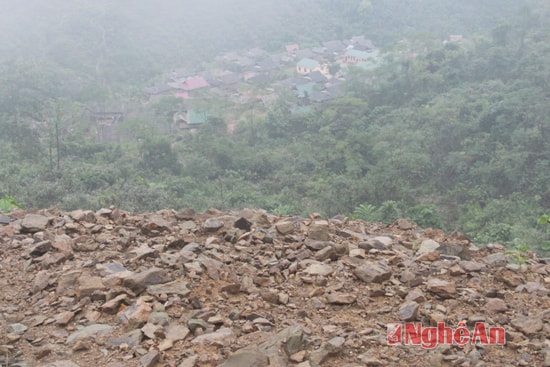 |
| The large block of rock and soil right above the village is threatening landslides. |
Ca Moong village is located on high ground, but the district road from the commune center is still several stories high. The road was under construction, and rocks and soil from there flowed down, damaging 12 houses. Rocks and soil flooded the entire village, but luckily the people were able to escape...
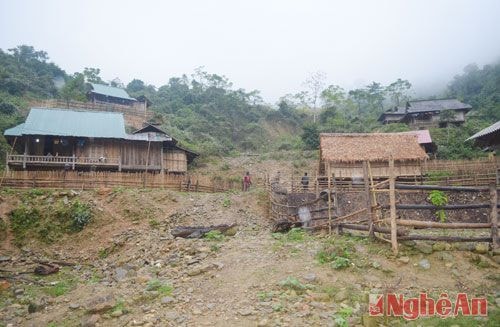 |
| Landslide area in 2014 in Ca Moong village |
After the incident, the Tuong Duong district government set up a task force to deal with the consequences, then handled the dam embankment, creating a channel to lead water from above to prevent landslides. "While cleaning the mud and rocks, the dam embankment, and clearing the flow, we also supported 12 households that collapsed and relocated 10 households at risk because they were located along the flow," said Mr. Phuc. "We are still very worried. There are still 3 households that have not yet moved out of the dangerous area. The road to the village has 2 sections that are about to break..."
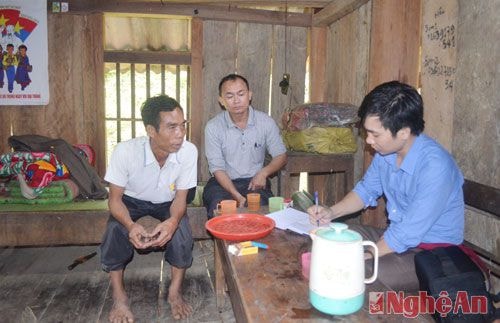 |
| Village chief Hap Van Phuc told the story to the reporter |
We climbed up to the high peak of Khe Pong mountain, where the road from the center of Luong Minh commune to Ca Moong is being built to see the embankment system to prevent landslides. Looking down from there, Ca Moong village is nestled in a valley, surrounded by mountains and forests. With such terrain, even though the embankment has been built, the fear of landslides during the rainy season still exists.
Lack of land for production, lack of electricity, lack of water
The old Ca Moong village belonged to Kim Da commune, about 8 km by water from the new village. During the implementation of the Ban Ve Hydropower project, the policy was to move people to resettlement areas in Thanh Chuong. With a heavy heart for the land of their ancestors, the people had many concerns, so they asked the government to let them move to Khe Pong valley to stabilize their lives. However, when they returned here, the surrounding forests and mountains were managed by the Forest Protection Management Board and could not be encroached upon. Therefore, every household was the same, leaving their children to the elderly, and those who were healthy took the boat back to the old village. Just like that, they worked on the fields and raised livestock all year round to have food to bring back to feed their families. Whenever there was a problem related to the community that required a meeting, the village chief followed the "falling wave" to call the production team leader to the old village, and a few days later, he would pass on the news for the villagers to return.
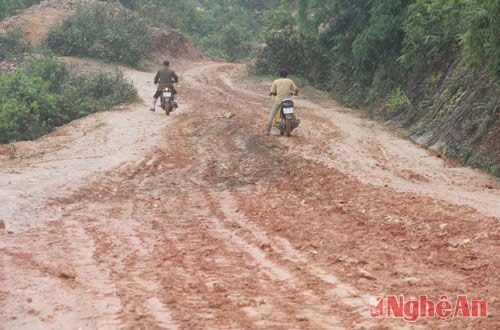 |
| The road to Ca Moong resettlement village has never been invested in. |
Visiting the entire Ca Moong village, we clearly saw the problem of lack of land for production. And it was also surprising, as this is a resettlement area of a key project, but the further we went, the more we saw the shortcomings in infrastructure investment. One principle of investment in resettlement area construction is to ensure electricity, roads, schools, stations, and domestic water systems. In Ca Moong, schools and stations exist, but there is no electricity; internal roads seem to have never been invested in; there is a self-flowing water system, but there is a lack of water... This situation has been widely reported by the press; the province and district have also taken an interest in it, but it has not been thoroughly resolved. And, the cause is said to be the irresponsibility of the investor, the Hydropower Project Management Board 2.
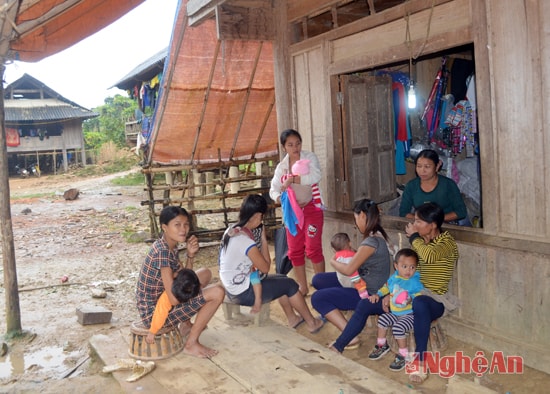 |
| Lacking land for production, the men in the village returned to their old village to make a living, leaving only women and children at home. |
According to the documents kept by Tuong Duong district, in July 2010, the Management Board of Hydropower Project 2 authorized the People's Committee of Tuong Duong district to invest in the construction of the resettlement area of Ca Moong village within an implementation period of 8 months. At that time, the hydropower reservoir began to prepare for water storage. And the Ca Moong resettlement area in Khe Pong area, Luong Minh commune was born. But when implementing the investment and construction, there were difficulties: All construction items here were surveyed and designed by the consulting unit according to standards, with full explanations, but were cut by the investor; to build a construction item, it must be approved by the Management Board of Ban Ve Hydropower Project before it can be implemented. “They are the investor, the district is only “authorized” to carry out. Therefore, whatever project they approve, the district will do. Even for the road leading to the village, at first they only approved digging and filling the roadbed to a width of 3.5 meters, the district had to spend 3 years debating before they allowed it to be widened to 6 meters…” – a district leader said.
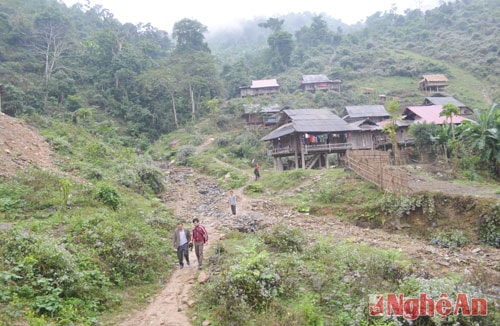 |
| Ban Ca Moong seen from above |
Raising questions: after the 2014 landslide, where did the funds to overcome the consequences come from? Since the people of Ca Moong moved to their new homes, what additional responsibilities does the Management Board of Hydropower Project 2 have to the people? It is known that after the landslide, Tuong Duong district asked the province, in addition, to allocate about 1.2 billion VND from the local budget to clean up, clear the flow, embank the dam, and support households whose houses collapsed, and relocate affected houses. As for the Management Board of Hydropower Project 2, there is no sign of it. "They wash their hands of the hydropower reservoir when it accumulates water" - the leader of Tuong Duong district affirmed. Again, asking: Does Tuong Duong not have an opinion so that the investor must show responsibility to the people who gave up their ancestors' land for them to carry out the project? The answer is: The Ca Moong incident has been through many forums but has not changed anything!.
Reviewing the “Temporary Regulations on Compensation, Migration and Resettlement”, Vietnam Electricity Corporation directed its member units to apply them to projects. In addition to land and property compensation issues, the regulations on implementing infrastructure in resettlement areas are very clear and detailed with full construction items and a set of standards sufficient to ensure people's lives when they move to their new homes... Comparing the regulations with what is seen in Ca Moong, the difference is “a world apart”.
Nhat Lan - Pham Bang






